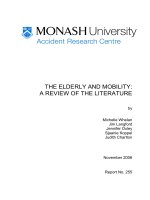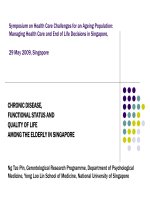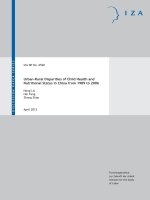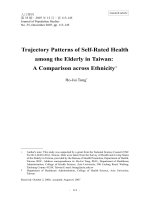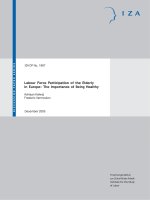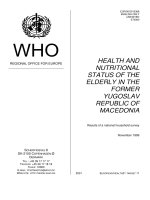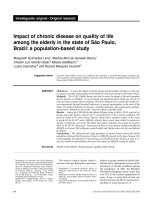Trajectory Patterns of Self-Rated Health among the Elderly in Taiwan: A Comparison across Ethnicity pptx
Bạn đang xem bản rút gọn của tài liệu. Xem và tải ngay bản đầy đủ của tài liệu tại đây (506.58 KB, 34 trang )
.
113
.
人口學刊
第 35 期,2007 年 12 月,頁 113-145
Journal of Popula tion Studi es
No. 35, December 2007, pp. 113-145
Trajectory Patterns of Self-Rated Health
among the Elderly in Taiwan:
A Comparison across Ethnicity
+
Ho-Jui Tung
*
+ Author's note: This study was supported b y a grant from the National Science Council (NSC
94-2412-H-016-001), Taiwan. Data were ta ken from the Survey of Health an d Living Status
of the Elderly in Taiwan, provided by the Bureau of Health Prom otion, Departm e nt of Health,
Taiwan, ROC. Address correspondence to: Ho-Jui Tung, Ph.D., Department of Healthcare
Administration, College of Health Science, Asia University, 500 Liufeng Road, Wufeng,
Taichung County 41354, Taiwan E-mail: h
* Department of Healthcare Administration, College of Health Science, Asia University,
Taiwan
Received: October 2 , 2006; accepted: August 6, 2007
research article
.
114
.
Journal of Population Studies No. 35
Abstract
This study seeks to compare health trajectories across the two major
ethnic groups of the elderly in Taiwan, the Taiwanese and the Mainlanders,
over 11 years of follow-up. This ethnic division is considered a salient
dimension of social stratification in Taiwan, shaping the two groups of
elders' pathways through life. Data are from the first four waves of the
Taiwan Survey of Health and Living Status of the Elderly (N=3,540).
Proportional hazard models with time-dependent covariates and
multinomial logistic regression were em ployed to compare health
trajectories across ethnicity. There are three major findings. (1) Self-rated
health is shown to be a remarkably strong predictor of mortality despite
controlling for other variables, which is consistent with th e bulk of s tudies
in this area. (2) By using a national representative sample of the elderly in
Taiwan and treating self-rated health as a time-dependent covariate,
evidence from this study reveals that self-rated health reflects a person's
health trajectory. (3) Considerable differences exist in the ways socio-
structural forces are related to the health trajectories of Mainlanders and
Taiwanese, respectively, over the 11 years of follow-up. In conclusion, it
seems that, among this elderly population, the ethnic inequality in health
can be explained away by Mainlanders' higher socio-economic standing,
which is different from the racial/ethnic health disparities observed in the
United States, where social class accounts for part of the differences, but the
health disparities between African Americans and whites remain after
adjusting for measures of social class.
Keywords: Taiwan, self-rated he alth, mortality, ethnicity, health
trajectory, elderly.
Ho-Jui T ung
.
115
.
I. Introduction
With the globally changing demographic structure, gerontology, the
study of aging, has gained increasing attention worldwide. Moreover, in
social gerontology, a growing body of literature has highlighted the
influence of ethnicity, minority status, and social class on the aging process.
This study seeks to compare health trajectories across the two major ethnic
groups of elders in Taiwan: the native Taiwanese
1
and the Mainlanders
(immigrants who moved from China's mainland to Taiwan around 1949 in
the aftermath of the Chinese Civil War) over the 11-year period from 1989
through 1999. This ethnic division is considered a salient dimension of
social stratification in Taiwan (Gates 1987), shaping the two groups'
members' pathways through life. Data collected on this elderly population,
who were born before 1929 and who have lived and grown old through a
period of rapid social change, are analyzed in order to improve our
understanding of how ethnicity and socio-structural variables are related to
their health trajectories in their later lives.
(1) Ethnicity and aging studies in Taiwan
Many sociological studies examining the ethnic division between
Mainlanders and Taiwanese have focused on comparisons of social
mobility, inter-marriage, ethnic identity and assimilation, and voter
mobilization (Chen 2005; Hu 1990; Tsai 1996; Wang 1993; Wu 1997,
2002). The reason that few studies have focused on the health status of
1 In this study , "Taiwanese" is used to refer to elders who were born in Taiwan. This study thus
labels not only the Hokl o (Minnan) but also the Hakka as Taiwanese, although there are
arguments that these two groups of Taiwanese differ culturally .
.
116
.
Journal of Population Studies No. 35
Mainlanders and Taiwanese elders is probably the lack of large-scale survey
data. Because of a dramatic decline in total fertility in Taiwan and the
expectation of a rapid transformation in age structure, more surveys
regarding the health and living status of the island's elderly population have
been collected. Among the studies that have made use of the data, Tung and
Mutran (2005) compared two measures of health status (self-rated health
and functional and disability status) between the Mainlander and Taiwanese
elders, finding significant health disparities between the two groups of
elders.
On the other hand, the study of old age in Taiwan has been dominated
by scholars from the fields of public health and health services, in which
population aging tends to be portrayed as a looming problem. The
underlying assumption that drives the studies and interventions toward old
age that older people are more vulnerable to chronic diseases and functional
disabilities, which may lead to greater use of health services and, eventually,
a greater likelihood of being institutionalized (Kaplan et al. 1993; Mor et al.
1994; Stuck et al. 1999; Verbrugge and Jette 1994). In the case of Taiwan,
the transformation of its population structure over a rel atively short period
has led the study of old age in Taiwan to focus on the cost and burden
attached to this demographic change (Wu and Chiang 1995). Less attention
has been paid to documenting the ethnic patterning of health between
Mainlander and Taiwanese elders. The current study is meant to fill this gap
and to explain how membership in one of the two ethnic groups is related to
group members' health trajectories over an 11-year period during their later
lives.
(2) Life Course Perspective
Social gerontology stresses the diversity within elderly populations
Ho-Jui T ung
.
117
.
and the influences of ethnicity and socio-structural forces on the aging
process. Researchers in this area call for closer scrutiny of the considerable
diversity, heterogeneity, and intra-cohort variability (Dannefer and
Uhlenberg 1999; Dannefer 2003; George 1993) within the cohorts of people
who share a collective social and historical circumstance. As Walker (1990)
points out, "older people (like their younger counterparts) are d ivided more
deeply among themselves, along social class and other lines than they are
united by the simple fact of sharing a common age group" ( Walker 1990:
391).
Particularly, the life course perspective argues that aging occurs from
birth to death as life transitions unfold and individuals enter and exit social
positions and roles over the life course (George 1993, 2003; Elder 1991,
1994). Here, life course refers t o "trajectories of role transitions and the
social pathways followed over particular phases of life" (Alwin and Wray
2005). In current study, the two ethnic groups of elders, Mainlanders and
Taiwanese, differ in one key feature: migration experience. The move of
Mainlanders to the island of Taiwan in the aftermath of the Chinese Civil
War can be seen as a social dislocation by which their normative sequences
of life transitions or trajectories were disrupted. When the war came along,
they were either drafted into the military or were forced to leave behind their
community in the mainland. This is similar to situation studied by Ryder
(1965); he compared the differences between American and European
societies, in terms of societal changes. "America may be less tradition-
bound than Europe because fewer young couples establish their homes in
the same place as their parents" (Ryder 1965:851), he wrote. In light of the
life course perspective, along with longitudinal data that follow people over
time, researchers in this area have begun to address questions like "Does the
linkage between socio-economic status (SES) and health change over
.
118
.
Journal of Population Studies No. 35
historical time?" "How can we identify different patterns of health
trajectory?" And "How are social-structural factors related to older people's
health trajectories over time?" So far, these lines of research have
documented that health disparities either increase over the life course
(House, Lantz, and Herd 2005; Mirowsky, Ross, and Reynolds 2000; Ross
and Wu 1995) or persist in later life (House et al. 1994; Liao et al. 1999),
because social advantages accumulate and compound to produce more
heterogeneity and inequality in older age (Dannefer 2003; Ferraro 2006).
(3) Trajectory of health
Examining older persons' health trajecto ries over time usually involves
some indicators of health over several measurement occasions, which
requires a longitudinal panel design. The single item, "regarding your state
of health, do you feel it is excellent, good, average, not so good, or poor,"
has proven a reliable predictor of mortality, even after controlling for
numerous measures of physical health (Idler 1999; Strawbridge and
Wallhagen 1999; Zimmer et al. 2000). It is also one of the most easily
measured concepts in social sciences (George 2003). Research focusing on
the link between this self-rated health measure an d mortali ty also points out
that the predictive value of this single item may lie in the explanation that
people incorporate their health changes into their health ratings (Ferraro and
Kelly-Moore 2001; Ferraro 2006), which means that self-rated health
actually reflects a person's health trajectory (Idler and Benyamini 1997;
Wolinsky and Tierney 1998; Liang et al. 2005). More important, in several
recent reports, researchers have also found that the self-rated health-
mortality association may differ among age and gender groups (Bath 2003;
Benyamini et al. 2003; Deeg and Kriegsman 2003). In order to move the
field forward, it becomes crucial to study the ways in which self-rated health
Ho-Jui T ung
.
119
.
are derived and how they may differ across different social groups (Idler
2003). However, most of these studies have been conducted in
industrialized countries; few have examined the situation in developing
countries (Frankenberg and Jones 2004; Yu et al. 1998). The current study
serves as an empirical test to address the following research questions. Is
self-rated health reported by the two ethnic groups of elders in Taiwan
predictive of their survival status 11 years later? If so, does self-rated health
represent judgments of health trajectories? That is, do the elders incorporate
health changes into the ratings of their own health? Are there differences in
the self-rated health-mortality relationships across ethnicity? If findings
from the previous analysis support a dynamic thesis of self-rated health,
then the use of self-rated health to represent health trajectories is
legitimized.
Finally, we know that all longitudinal surveys face the problems of
panel attrition and potential selection effects (Ferraro and Kelly-Moore
2003). Consequently, the respondents' long-term and short-term survival
statuses are included to identify six health trajectories among this elderly
population. The final analysis deals with how ethnicity and other socio-
structural variables are related to these health-trajectory patterns over the 11
years of follow-up.
II. Data and Methods
(1) Sample
Data for this study are from the first four waves of the Taiwan Survey
of Health and Living Status of t he Elderly, which is a panel-design
longitudinal survey. A national representative sample of people 60 or older
.
120
.
Journal of Population Studies No. 35
in 1989 was drawn. Twenty-seven strata with roughly equal size were
identified, stratified by th ree administrative levels (city, urban township,
and rural township), three levels of education, and three levels of total
fertility rate. Among the 4,412 persons selected for the survey, 4,049
responded, yielding a response rate of 91.8%. When the first follow-up
occurred in 1993, 3,155 elders were successfully re-interviewed, with a
response rate of 91.0% after excluding the deceased cases from the
denominator. The next three follow-ups took place in 1996 (2,669 cases
were retrieved, with a response rate of 88.9%), in 1999 (2,310 cases were
re-interviewed, with a response rate of 90.1%), and in 2003 (2,036 cases
were interviewed). Detailed descriptions of sampling and the questionnaire
are provided elsewhere (Taiwan Provincial Institute of Family Planning
1989).
Because a major purpose of this study was to compare the health
trajectories across the two ethnic groups of elders in Taiwan, Mainlanders
and Taiwanese, we excluded 95 respondents who identified themselves as
having "other" ethnicity. In addition, we also found that self-rated health
was not available for proxy interviews, so another 137 cases with missing
self-rated health at baseline were also excluded from the analysis. For the
respondents who had their self-rated health recorded in the first wave but
were found missing on this item in the follow-ups, an imputed value of self-
rated health was assigned to them based on following principles: (1) if their
second-wave measures were missing, these were replaced with an average
of the first- and third-wave measures; (2) if their third-wave measures were
missing, these were replaced with an average of their second- and fourth-
wave measures; (3) if more than two waves of the measures were missing,
then the cases were deleted. As a result, another 277 cases were deleted
from the analysis. That left 3,540 cases available for this study; their
Ho-Jui T ung
.
121
.
Ta ble 1: Percentage Distribution of Sample Characteristics by Ethnicity
Total (N=3540)
Taiwanese (N=2759) Mainlander(N=781)
Gender (Male) 49.8 83.2
Education (schooling in years)
no schoolin g 49.3 14.2
less than primary (1-6 years) 40.3 37.6
above high school (7+ years) 10.4 48.1
Age in 1989
younger cohort (60-69) 62.8 76.1
older cohort (70+) 37.2 23.9
Monthl y i ncome (NT$)
<5000 32.9 7.3
>5000 67.1 92.7
Live alone (=1) 5.8 20.7
W idowed (=1) 32.0 13.6
Smoking s tatus
current smoker 32.4 42.9
ex-smoker 11.9 24.1
non-sm oker 55.7 33.0
Presence of any 5 serious conditions
a
34.1 37.5
Presence of any 4 ADL
b
34.8 16.6
Self-rated health in 1989
excellent 14.4 27.7
very good 21.6 23.4
average 40.3 29.8
not so good 19.4 15.6
poor 4.3 3.5
Note:
a
hypertension, cancer, diabetes, heart diseases, and stroke.
b
difficulties in wa lking, ba thing, using the phone, and managing money.
.
122
.
Journal of Population Studies No. 35
characteristics are presented in Ta ble 1.
(2) Measures
The survival status of the original 4,049 respondents was determined
by cross-checking the death certificate registration system, which is
managed by Taiwan's Cabinet-level Department of Health, and the
household-registration system, which is maintained by Taiwan's Ministry of
the Interior. For the deceased respondents, their dates of death ( detailed in
months) were obtained. Since mortality information was not available past
December 1999, only the first four waves of the survey data were used.
Cases who were alive after December 1999 are treated as censored. Of the
3,540 original respondents interviewed in 1989, 1,427 (40.3%) had died by
1999.
The measurement of self-rated health is a single item, "Regarding your
state of health, do you feel it is excellent (coded 1), good, average, not so
good, or very poor (coded 5)." Thus, higher scores mean the perception of
poorer health. This 5-category measure was used when examining the
relationship between self-rated health and survival status over the 11-year
period. It is argued tha t using the 5-category item and treating it as a
continuous variable could prevent the coarseness involving collapsing the 5
categories into fewer responses. Plus, it would be more parsimonious when
treating self-rated health as a time-dependent covariate ( Ferrarro and
Kelley-Moore 2001). However, in identifying trajectory patterns, the 5-
category self-rated health was dicho to mized into simply "good" (for
excellent, good,andaverage) and "poor" (for not so good and very poor).
Based on transitions of self-rated health across waves and respondents'
survival status, 7 major trajectory patterns were identified:
(1) stable poor health: those who survived the whole 11 years and rated
Ho-Jui T ung
.
123
.
their health as "not so good" or "very poor" throughout the four wa-
ves
(2) died later: those who died between 1994 and 1999
(3) died early: those who died before the end of 1993
(4) early d eterioration: those who survived the whole observation per-
iod and had a baseline self-rated health better than average, but
who also declined into the "not so good" or "very poor" categories
in the earlier waves
(5) late deterioration: those who survived the whole observation period
and maintained an above-average self-rated health until the third
wave, when it deteriorated into the "not so good" or "very poor"
categories for the last wave
(6) stable good: those who survived the whole 11 years and rated their
health as excellent, good, or average through the four waves of the
survey
(7) no clear pattern: those who survived the whole 11 years but had
fluctuating ratings of self-rated health over the period; their com-
parisons against the other trajectories are not the focus of this
analysis.
Finally, it should be noted that for the purposes of illustration (see Figure 1)
the original coding for self-rated health has been reversed, so that excel-
lent=5 and "very poor"=1. In addition, another category was added: "dead"
(=0).
A variety of covariates, along with self-rated health, are included to
predict the outcome variable. First, covariates centered on the mechanisms
linking the Mainlander and Taiwanese elders' social position to their health
status (Hayward et al. 2000) are included; these include gender, age,
ethnicity, and measures of socio-economic status (SES). The sign ificance of
.
124
.
Journal of Population Studies No. 35
Figure 1. The six trajectory patterns and their average self-rated health
across waves.
Ho-Jui T ung
.
125
.
ethnicity (Taiwanese=1; Mainlanders=0) has been discussed previously.
Gender (male=1 and female=2) and age are fundamental social relations
and have both profound biological and social influences on health. Age was
dichotomized into two cohorts: "younger" (aged 60 – 69 in 1989) and "
older" (aged 70 and over in 1989). Educational attainment (years of
schooling) is also fundamental in reflecting an individual's childhood social
class circumstances, shaping health behaviors (such as smoking), and
increasing self-efficacy and sense of control (Ross and Wu 1995). Measure
of educational attainment is collapsed into 3 groups (no schooling, less than
primary school, and high school and above) in the multinomial logistic
regression analysis. Higher income is associated with bett er access to health
care and economic resources. Monthly income (including spouse's) in 1989
is measured by a seven-category item: less than NT$3,000 (=1), NT$3,000
to NT$4,999 (=2), NT$5,000 to NT$9,999 (=3), NT$10,000 to NT$14,999
(=4), NT$15,000 to NT$20,000 (=5), NT$20,000 to NT$49,999 (=6), and
NT$50,000 and over (=7). This income information, however, was missing
for 397 cases. Their income measures were replaced with the median
incomes imputed from their gender and education-level groupings. These 7-
category income measure are treated as continuous variables in the survival
analyses, but were dichotomized (below or above NT$5,000) in the
multinomial l ogistic regression.
The health-protection effect of social relationships is well documented
(House, Umberson, and Landis 1988). In a society where informal care
provided by families accounts for most of the care burden, support for the
old often takes the form of living together. Another included indicator of
social relationships is widowhood. Both of these are dichotomous
measures, where 1 equals the name of the variables and 0 means all others.
A lifestyle health behavior measure is included as well. Dummy
.
126
.
Journal of Population Studies No. 35
variables are created to differentiate the elders' smoking status: one for the
current smokers against all others, another for the past smokers against all
others.
For health-related covariates, a measure of presence of any five serious
conditions is used. In each wave of the survey, the respondents were asked,
"Has a doctor ever told you that you have hypertension, diabetes, heart
problems, stroke, or cancer?" For each of the conditions, "yes" is coded 1,
with other answers coded 0. Since the survey was conducted among
community-dwelling elders, relatively few had these serious conditions; so
we decided to collapse them further into one dichotomous measure
(presence of any of the five conditions is coded 1, and freedom from all of
these conditions is coded 0). Finally, functional status at baseline is assessed
by a composite of 4 items (bathing, walking short distance, managing
money, and using the phone) measuring both the difficulties of activities of
daily living (ADL) and instrumental activities of daily living (IADL).
Again, relatively few of these community -dwelling elders had any ADL or
IADL disabilities, so they are collapsed into one dichotomous measure
(presence of any of the four difficulties is coded 1, and freedom from all of
the difficulties is c oded 0).
III. Analysis
When examining the relationship between mortality and self-rated
health, proportional hazard models for survival analysis are employed.
Several analyses were conducted to compare findings. First, respondents'
baseline self-rated health (referred to as W1 in the tables) was entered, along
with other risk factors, to predict mortality over the 11 years. Next, time-
dependent self-rated health and serious conditions were introduced into the
Ho-Jui T ung
.
127
.
models.
According to Allison (1995), there are several way s to implement the
time-dependent covariates, most of which require some manipulation of the
data structures. For our data, a major challenge is that self-rated health and
other covariates were measured at four irregular intervals (at baseline, 1993,
1996, and 1999), which do not correspond to the unit of survival time (you
can count how many months has lapsed or how many years has lapsed since
the beginning). As a result, we have to take the most recent values and scale
them by time of observation in years. In essence, a time stamp is placed on
the most recent values, and related SAS codes are given to pick up the most
recent measures for the two time-dependent covariates (self-rated health
and serious chronic conditions). For the time-dependent measures in the
years between waves, the most recent available measures are assigned to
them. When the time-dependent covariates are incorporated, When the
time-dependent covariates were incorporated, the dynamic thesis of self-
rated health can be evaluated by comparing findings from models with and
without time-dependent covariates. If older people do incorporate health
changes into their health ratings, self-rated health should remain a
significant predictor in these models. Indeed, one may expect that its
association with mortality would be stronger.
Multinomial logistic regression is used to model the factors predicting
different health trajectories over the observation period. When modeling the
six health-trajectory patterns, the aim is to identify predictors differentiating
those who had consistent good health from other health trajectories.
Accordingly, likelihood of other trajectories is modeled against that of
consistent good health in the multinomial logistic regression analysis.
.
128
.
Journal of Population Studies No. 35
IV. Results
(1) Self-rated health-mortality relationship
The results o f the baseline and time-dependent self-rated health
analyses are p resented in Table 2. Hazard ratios and their 95% confidence
intervals (CI) are presented for the total and separately for Mainlander and
Taiwanese elders, where model 1 uses the baseline self-rated health and
model 2 treats self-rated health as a time-dependent covariate (referred as
TDC in the tables). From the first column of Table 2, we can see that
baseline self-rated health is highly p redictive of mortality over the 11 years.
The hazard ratio for this W1 self-rated health measure is 1.28, which means
that, on average, the risk of mortality increases by 28% per single unit down
the rating scale (1=excellent; 5=very poor). Presence of any of the five
serious conditions and any of the four disabilities are also associated with
higher mortality, as are gender, age, being widowed, and being a current
smoker. Among SES indicators, education (years of schooling) is only
modestly associated with mortality.
Although mortality does not differ across ethnicity, when controlling
for other covariates, there are considerable differences in terms of which
factors are more important in predicting mortality risk between Mainlander
and Taiwanese elders. By comparing the second and t hird columns of Table
2, we see that education's health-protection effect is more pronounced for
Taiw anese elders. On the contrary, it seems that income is more associated
with mortality among Mainlanders in predicting mortality over the 11 years
of follow-up. In terms of indicators of social relationships, widowhood is a
strong predictor of mortality for Taiwanese elders but not for Mainlanders.
Ho-Jui T ung
.
129
.
Table 2. Hazard Ratios and Confidence Intervals from Proportional
Hazard Models of Mortality with and without Time-dependent
Covariates (TDC) and by Ethnicity
Total Taiwanese Mainlander
Model 1 Model 2 Model 1 Model 2 Model 1 Model 2
Self-rated he alth,
W1
1.28***
(1.21-1.36)
1.30***
(1.23-1.39)
1.20**
(1.07-1.36)
Self-rated he alth,
TDC
1.37***
(1.30-1.44)
1.37***
(1.28-1.45)
1.39***
(1.24-1.57)
Presence of any 5
serious conditions,
W1
1.40***
(1.25-1.56)
1.381***
(1.23-1.54)
1.41***
(1.25-1.60)
1.42***
(1.25-1.61)
1.34*
(1.04-1.72)
1.225
(.96-1.59)
Gender (male) .54***
(.46 64)
.55***
(.46 65)
.53***
(.44 64)
.54***
(.45 66)
.52**
(.35 82)
.52**
(.34 81)
Education
(schooling in years)
.96
§
(.92-1.00)
.97
(.93-1.01)
.94*
(.89-1.00)
.94
§
(.89-1.00)
1.01
(.92-1.06)
1.03
(.942-1.08)
Age ( older) 2.43***
(2.17-2.73)
2.42***
(2.16-2.71)
2.32***
(2.03-2.62)
2.32***
(2.03-2.61)
2.90***
(2.33-3.83)
2.89***
(2.32-3.80)
Income .99
(.88-1.13)
.99
(.86-1.11)
1.10
(.89-1.16)
1.01
(.88-1.14)
.90
§
(.54-1.12)
.90*
(.52-1.14)
Ethnicity 1.06
(.92-1.24)
1.06
(.92-1.23)
Live Alone 1.17
§
(.99-1.39)
1.16§
(.98-1.38)
.95
(.75-1.19)
.95
(.75-1.19)
1.57**
(1.27-2.19)
1.53**
(1.25-2.14)
Widowed 1.37***
(1.21-1.56)
1.35***
(1.19-1.54)
1.46***
(1.27-1.67)
1.43***
(1.24-1.63)
1.17
(.82-1.72)
1.16
(.81-1.70)
Current smoker 1.31***
(1.12-1.54)
1.32***
(1.12-1.54)
1.28**
(1.07-1.54)
1.30**
(1.08-1.56)
1.42*
(1.05)
1.38*
(1.01-1.89)
Past smoker 1.05
(.87-1.26)
1.06
(.88-1.27)
1.09
(.87-1.35)
1.12
(.90-1.40)
.99
(.70-1.42)
.96
(.68-1.37)
Presence of any
disabilities
1.63***
(1.44-1.85)
1.62***
(1.43-1.83)
1.61***
(1.39-1.84)
1.61***
(1.39-1.83)
1.81***
(1.37-2.48)
1.68***
(1.28-2.30)
-2 Lo g L 799.22 845.30 629.18 655.02 175.40 194.14
Degree of freedom 12 12 11 11 11 11
Note: Values are hazard ratios (95% confidence interval). W1= Wave 1. TDC=Time-dependent co-
variate.
§p<0.10; *p<0.05; **p<0.01; ***p<0.001
.
130
.
Journal of Population Studies No. 35
To live alone is highly predictive of dying over the 11 years among
Mainlander e lders; this, how ever, is not seen among their Taiwanese
counterparts.
When treating self-rated health as a time-dependent covariate, it is not
only a significant predictor of mortality o ver the 11 years of follow-up; its
effect is also much stronger. This stronger effect is seen for the total sample
and for both of the sub-samples (Mainlander and Taiwanese). For example,
looking at model 2 for the total sample, one-unit increase in self-rated health
would lead to a 3 7% (HR=1.37) incease in morality risk ove r the 11 years
of follow-up, with adjustments for socio-structural and SES variables as
well as health-related risk factors. This provides evidence to support the
thesis that self-rated health actually reflects a "dynamic, rather than static,
perspective on health" (Idler and Benyamini 1997; Wolinsky and Tierney
1998; Ferraro and Kelly-Moore 2001). For the Taiwanese and Mainlander
sub-samples, the pattern of significant findings is very similar across
ethnicity. For Mainlander elders, however, when treating self-rated health
as a time-dependent covariate (model 2), a notable difference between the
two ethnic groups is found (in terms of the predictive value of the presence
of any serious conditions related to mortality). That is, the association
between the presence of any serious conditions and mortality disappears
(model 2 for the Mainlander sub-sample) o nce including self-rated health as
a time-dependent covariate.
In Table 3, another time-dependent covariate, the presence of any
serious conditions, is added to further evaluate the dynamic thesis of self-
rated health. From Table 3 we see that, again, self-rated health is a
significant predictor of mortality for the total sampl e and for both the
Taiwanese and the Mainlander sub-samples. A striking difference between
the two ethnic groups appears, however, when morbidity information is
Ho-Jui T ung
.
131
.
Table 3. Hazard Rations and Confidence Intervals from Proportional
Hazard Models of Mortality with Multiple Time-dependent
Covariates (TDC) and by Ethnicity
Total Taiwanese Mainlander
Model 1 Model 2 Model 1 Model 2 Model 1 Model 2
Self-rated he alth,
W1
1.30***
(1.23-1.37)
1.32***
(1.24-1.40)
1.22**
(1.09-1.38)
Self-rated he alth,
TDC
1.37***
(1.30-1.44)
1.36***
(1.28-1.44)
1.41***
(1.26-1.60)
Presence of any
serious conditions,
DTC
1.42***
(1.27-1.58)
1.32***
(1.19-1.48)
1.47***
(1.30-1.66)
1.39***
(1.23-1.57)
1.21
(.95-1.55)
1.06
(.83-1.37)
Gender (male)
.54***
(.46 64)
.55***
(.47 65)
.52***
(.43 64)
.54***
(.45 66)
.54**
(.36 85)
.53**
(.35 84)
Education
(schooling in years)
.96
§
(.92-1.00)
.97
(.93-1.01)
.94*
(.89-1.00)
.95
§
(.90-1.00)
1.11
(.93-1.06)
1.03
(.95-1.08)
Age ( older)
2.45***
(2.18-2.74)
2.43***
(2.17-2.72)
2.34***
(2.05-2.64)
2.33***
(2.04-2.63)
2.91***
(2.34-3.84)
2.89***
(2.32-3.81)
Income
1.00
(.89-1.14)
.99
(.87-1.12)
1.01
(.90-1.16)
1.01
(.88-1.15)
.91
§
(.57-1.25)
.90
§
(.53-1.17)
Ethnicity
1.06
(.92-1.24)
1.05
(.91-1.22)
Live Alone
1.17
§
(.99-1.39)
1.17
§
(.99-1.39)
.95
(.75-1.19)
.96
(.76-1.20)
1.58**
(1.28)
1.54**
(1.25-21.5)
Widowed
1.39***
(1.23-1.58)
1.36***
(1.20-1.55)
1.48***
(1.28-1.69)
1.45***
(1.25-1.65)
1.15
(.81-1.70)
1.14
(.80-1.68)
Current smoker
1.31***
(1.12-1.53)
1.30**
(1.11-1.52)
1.28**
(1.06-1.54)
1.29**
(1.07-1.54)
1.41*
(1.04-1.94)
1.37*
(1.01-1.88)
Past smoker
1.04
(.87-1.26)
1.06
(.88-1.28)
1.09
(.87)
1.12
(.89-1.39)
1.00
(.71-1.43)
.97
(.69-1.39)
Presence of any
4ADL
1.64***
(1.45-1.86)
1.64***
(1.45-1.86)
1.61***
(1.39-1.84)
1.63***
(1.41-1.86)
1.84***
(1.39-2.53)
1.71***
(1.30-2.34)
Wald Chi-square 797.54 833.03 630.63 648.05 173.40 191.95
Degree of freedom
12 12 11 11 11 11
Note: Values are hazard ratios (95% Confidence Interval). W1= Wave 1. TDC=time-dependent co-
variate.
§p<0.10; *p<0.05; **p<0.01; ***p<0.001
.
132
.
Journal of Population Studies No. 35
treated as time-dep endent: the presence of serious conditions is unrelated to
mortality among Mainlander elders over the 11 years of follow-up. It seems
that t hese life-threatening conditions are n ot so "threatening" among the
Mainlander elders, when compared to conditions reported by their
Taiwanese counterparts.
(2) Trajectory patterns
The results of multinomial logistic regressions predicting different
health trajectories across the two ethnic groups of elders are presented in
Table 4-1 to Table 4-3. For each predictor, odds ratios (OR) for comparing
the trajectories of the "stable poor health," "died later," "died early," "early
deterioration," and "late deterioration" categories against that of "stable
good health" are reported for the whole sample (Table 4-1) and separately
for the Taiwanese (Table 4-2) and Mainlanders (Table 4-3). Comparisons
for the trajectory of "no clear pattern" are not the focus of this study and so
are not shown here.
Starting from gender's effect on differentiating health trajectories, it is
Total Sample (Total N=3540, the "Stable Good" N=947, and the "No Clear Pattern" N=539)
Trajectory Pattern
Stable Poor
Health (N=91)
Died Later
(N=936)
Died Early
(N=491)
Early Deterioration
(N=265)
Late Deterioration
(N=271)
Gender (male) .65 1.38* 2.01*** .58* .59*
Education
no schooling 3.96** 1.81*** 1.77** 2.64*** 1.34
1-6 years 2.17 1.29 1.07 1.06 .80
Older cohort .68 3.42*** 4.18*** 1.00 1.77***
Lower income 2.00** 1.54** 1.18 1.30 1.19
Ethnicity
(Mainlander)
1.41 .88 .88 1.25 .83
Live alone 1.56 1.59* 1.39 1.07 .84
Widowed .79 1.24 1.75*** 1.02 1.23
Current smoker .87 1.76*** 1.64** 1.19 1.71*
Past smoker 1.73 1.25 1.42 1.53 1.74*
Having any 5 serious
conditions
4.70*** 2.72*** 3.56*** 1.98*** 1.05
Having any 4 ADL 7.47*** 3.28*** 6.47*** 2.45*** 1.42
Table 4-1. Odds Ratios from Multivariate Multinomial Logistic Regression Predicting Health Trajectory patterns:
§p<0.10; *p<0.05; **p<0.01; ***p<0.001
Ho-Jui T ung
.
133
.
clear that although male elders were 1.38 (p<.05) times more likely to die
before 1993 and 2.01 (p<.001) times more likely to die after that year, they
were less likely to experience an early (OR=.58, p<.05) or a late (OR=.59,
p<.05) deterioration of self-rated health than their female counterparts.
However, when considering gender differences in trajectory patterns across
ethnicity, a striking difference is found between Taiwanese and
Mainlanders. That is, the gender mortality gap (male Taiwanese are more
likely to die over the follow-up years) is not observed among the
Mainlanders. However, it should be noted that the gender composition is
extremely skewed among the Mainlanders. Only 16.8% of the Mainlander
sample are female (see Table 1).
In terms of the health-protection effects of SES indicators, compared
with those who have more than 7 years of schooling, elders with no formal
schooling have significantly higher odds of staying in poorer health
(OR=3.96, p<.01), dying before 1993 (OR=1.77, p<.001) or after that year
(OR=1.81, p<.001) or experiencing an "early deterioration" (OR=2.64, p<.
001) of self-rated health. However, education's effects on health are l ess
salient between elders who had less than 6 years of schooling and those who
Trajectory Pattern
Stable Poor
Health (75)
Died Later
(N=754)
Died Early
(N=397)
Early Deterioration
(N=208)
Late Deterioration
(N=215)
Gender (male) .65 1.54* 2.18*** .62
§
.64
§
Education
no schooling 3.68* 2.03*** 1.65* 2.29** 1.83*
1-6 years 1.66 1.29 .98 .95 .93
Older cohort .82 3.31*** 3.97*** .98 1.76**
Income (lower) 2.16** 1.50** 1.23 1.47* 1.26
Live alone 1.44 1.32 .75 .86 1.05
Widowed .77 1.41* 2.14*** 1.09 1. 25
Current smoker 1.00 1.64** 1.47
§
1.04** 1.74*
Past smoker .97 1.19* 1.39 1.27 2.10*
Having any 5 serious
conditions
3.84*** 2.63*** 3.50*** 1.72** .97
Having any 4 ADL 5.50*** 3.01*** 5.78*** 2.22*** 1.23
Taiwanese Sample (Total N=2759, the "Stable Good" N=676, and the "No Clear Pattern" N=434)
Table 4-2. Odds Ratios from Multivariate Multinomial Logistic Regression Predicting Health Trajectory patterns:
§p<0.10; *p<0.05; **p<0.01; ***p<0.001
.
134
.
Journal of Population Studies No. 35
had 7 or more years of schooling. Lower-income elders are also more likely
to stay in the "stable poor health" trajectory (OR=2.00, p<.01) or to die after
1993 (OR=1.54, p<.01). Regarding the differences in trajectory patterns
across ethnicity, it seems that these SES indicators' health-protection effects
are more salient in differentiating health trajectories among Taiwanese
elders than they are among Mainlander eld ers. For example, income is not
a significant predictor of health trajectories among the Mainlanders. For
Mainlanders, education only matters in predicting the trajectory of "early
deterioration."
There is some evidence that social relationships are associated with
mortality over the follow-up years; but they operat e in different ways across
ethnicity. Widowhood is associated with mortality only among Taiwanese
elders. On the other hand, Mainlander elders would be more likely to die
over the period if they lived alone in 1989.
Smoking has been one of the leading causes of preventable death in
Taiwan (Wen, Tsai, and Yen 1994); and from this study it seems that it is
never too late to quit smoking. Those who were smoking in 1989 (the
current smokers) were more likely to die over the follow-up years. Past
Trajectory Pattern
Stable Poor Health
(N=16)
Died Later (N=182) Died Early (N=94)
Early Deterioration
(N=57)
Late Deterioration
(N=56)
Gender (male) .64 1.04 1.77 .52 .41*
Education
no schooling 3.02 1.21 2.07 3.71* .52
1-6 years 3.43 1.45 1.02 1.02 .91
Older cohort .18 3.78*** 5.30*** 1.17 1.65
Income (lower) 1.36 1.91 .77 .17 .27
Live alone 1.40 1.96* 2.68** 1.18 .61
Widowed .64 .65 .78 .85 1.25
Current smoker .44 1.88* 1.98
§
1.56 1.47
Past smoker 2.78 1.39 1.61 2.04
§
1.07
Having any 5 serious
conditions
13.78*** 2.81 3.33*** 2.82*** 1.27
Having any 4 ADL 27.70*** 5.68*** 14.29*** 4.97** 3.48*
Mainlander Sample (Total N=781, The "Stable Good" N=271, and The "No Clear Pattern" N=105)
Table 4-3. Odds Ratios from Multivariate Multinomial Logistic Regression Predicting Health Trajectory patterns:
§p<0.10; *p<0.05; **p<0.01; ***p<0.001
Ho-Jui T ung
.
135
.
smoking behavior, however, was not associated with mortality over the
follow-up years.
Finally, those who had any of the five serious conditions in the first
wave are more likely to experience an "early deterioratio n" of self-rated
health, to stay in the "stable poor health" trajectory, and to die, while those
who had any of the four disabilities were also more likely enter the "early
deterioration" trajectory, to stay in the "stable poor health" trajectory, and to
die.
V. Discussion
For this studied cohort of elders, the ethnic division between
Mainlander and Taiwanese elders is considered a salient dimension of social
stratification, shaping the two groups of elders' pathways through life.
Emanating from this argument, this study empirically examines the health
trajectories of these two ethnic groups of elders over 11 years of follow-up.
There are three major findings. (1) Self-rated health is shown to be a
remarkably strong predictor of mortality despite controlling for other
variables, which is consistent with the bulk of studies in this area. (2) By
using a national representative sample of the elderly in Taiwan and treating
self-rated health as a time-dependent covariate, evidence from this study
reveals that self-rated health reflects a person's health trajectory. (3)
Considerable differences exist in the ways socio-structural forces are related
to the health trajectories of Mainlanders and Taiwanese, respectively, over
the 11 years of follow-up. The social implications from these findings are
discussed here.
First, although the association between self-rated h ealth and mortality
is quite similar between the Taiwanese and Mainlander sub-samples,
.
136
.
Journal of Population Studies No. 35
association patterns of many covariates do differ across ethnicity. For
example, in terms of educational attainment, we know that educational
opportunities were quite limited during the childhood and adolescence of
this cohort of elders. This is especially true among the Taiwanese sub-
sample. Almost 50% of them are illiterate. So, a plausible explanation of
why low education is not predictive of mortality among the Mainlanders
might be that a majority of them have at least some years of schooling, so
there is little variation in the measure of education among Mainlanders to
show its effect. On the other hand, it appears that the beneficial effect of
income is more important for Mainlander elders, relative to the effect of
education. Compared to Taiwanese elders, Mainlanders also have a higher
average income. (A significant proportion of Mainlanders were on a variety
of government pension programs.) At the same time, it could be that
Mainlander elders have wider income gaps among them, when compared to
their Taiwanese counterparts.
Turning to the two indicators of social relationships, living alone and
being widowed, a very different asso ciation patterns across ethnicity is
seen. As mentioned previously, in a society where the norm of filial piety is
strongly emphasized, support for the elderly mainly takes the form of living
with families (usually the older person's sons). Actually, even in the United
States, where older people prefer to live independently when they can, a
substantial number of the very old share homes with their children or other
relatives (Golant 1996).
From the baseline survey, we know that for this cohort of elders
marriage was a norm. This can be seen from the fact that marriage was
almost universal among the Taiwanese sub-sample; but some 13% of the
Mainlander elders never got married. Consequently, Mainlanders would
have fewer children. Taiwanese would be more likely to live in an extended
Ho-Jui T ung
.
137
.
family with their married children. Mainlanders might be less likely to
receive a variety of support and assistance from their families. Al l of these
point toward an intra-cohort differentiation of life course trajectories
between these two groups of elders. Moreover, the types and sizes of their
social ties would obviously differ significantly, which, in turn, influences
their life chances during their later lives.
Another notable difference across ethnicity is that the measure of
serious conditions is not predictive of mortality among the Mainlanders.
From the facts that Mainlanders have better access to health care and a
significantly higher proportion of Mainlander elders have regular health
check-ups, it is suspected that Mainlanders would likely be more aware of
their chronic conditions, while conditions among the Taiwanese would go
undiagnosed until they become more severe or even terminal.
Finally, even though there are significant mortality differentials
between the two ethnic groups of elders, this ethnic disparity disappears
when other socio-structural variables are taken into account. That is,
ethnicity in this elderly population implies a social position that cut across
other elements in the system of social stratification, such as SES, gender,
and class ; it also shares a lot of variance within these social structural
variables. This is different from the racial/ethnic disparities of health
observed in the United States, where social class accounts for part of the
dif ferences, but the health disparities between African Americans and
whites remain after adjusting for measures of social class. As commented
by Alwin and Wray (2005), the race/ethnic differences in health between
African Americans and whites probably result from "patterns of
institutional racial and ethnic discrimination that produce differential social
pathways contributing to different health outcomes." On the contrary, the
Mainlander and Taiwanese e lders have lived o n the island for more than half

